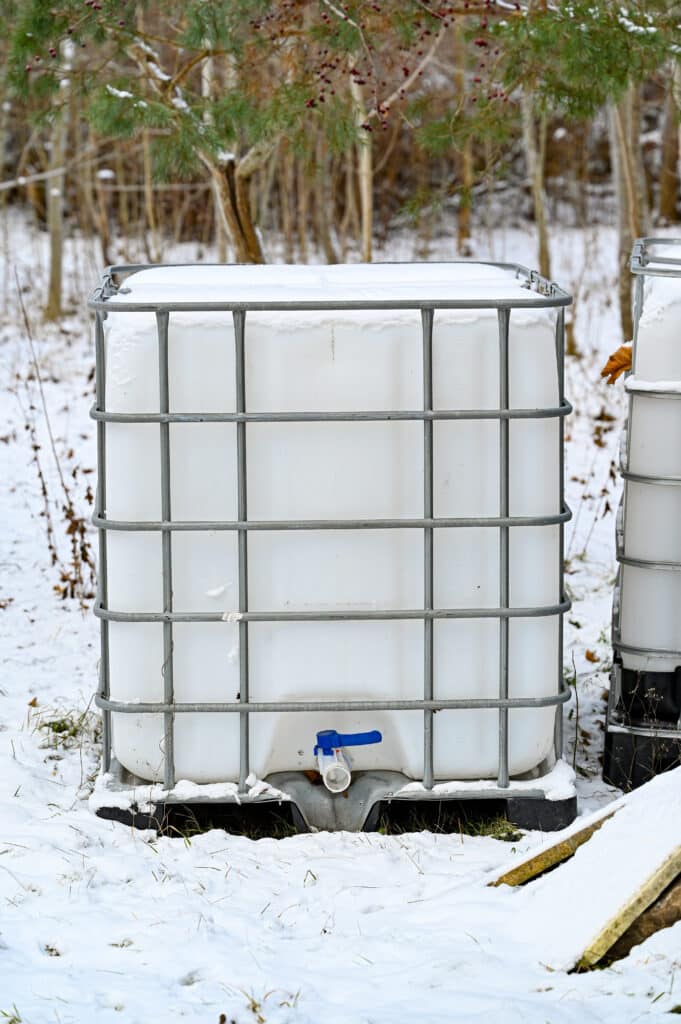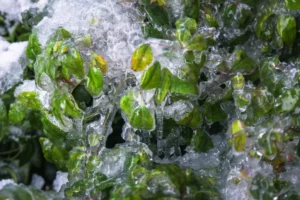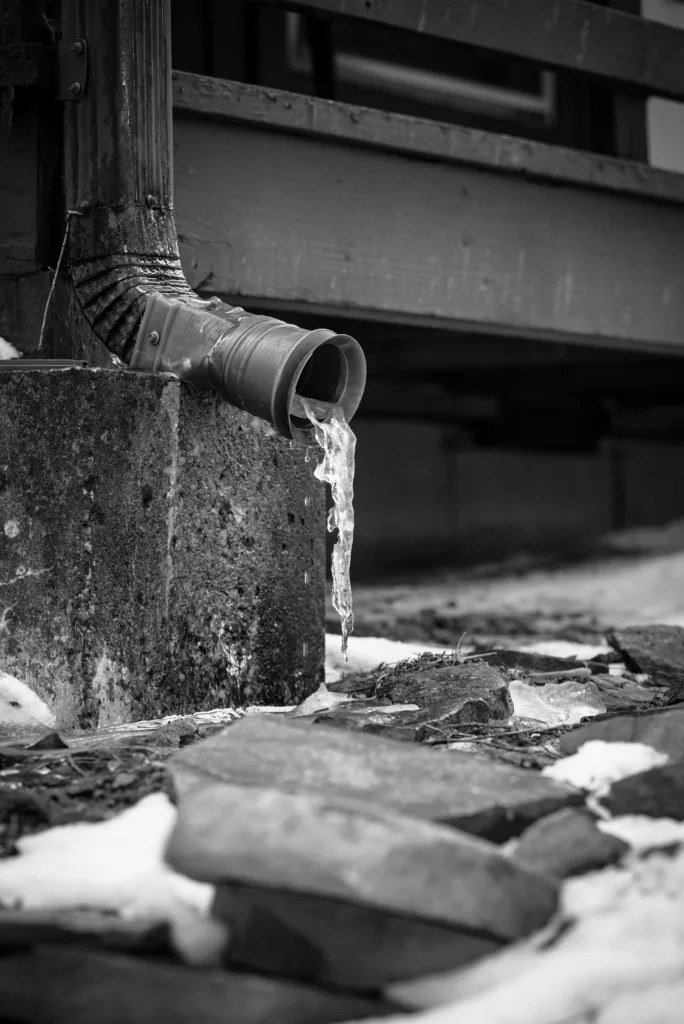As the leaves change and temperatures dwindle day after day, you have probably noticed you need to begin prepping for the colder seasons. With those changes comes the time to winterize your yard for those sub-freezing temperatures and winter precipitation. You probably know that you must insulate your plants, drain or cover your pool, or allow pipes to drip slowly to keep water flowing. But did you know that your green infrastructure, such as rain barrels or permeable pavers, also needs winterization? Without proper preparation, water left in these systems could damage the structural integrity and cause operational failures.
What is Green Infrastructure?
Green Infrastructure, popularly known as low impact development or eco-development, is an alternative to gray infrastructure systems (e.g. municipal sewer, metal pipes). Generally, green infrastructure replaces the traditional method of moving stormwater “out of sight and out of mind” by, instead, treating the stormwater onsite through a green-filtration mechanism (e.g. bioretention, rain garden, or permeable paving). Green infrastructure mimics nature and deals with stormwater onsite rather than introducing it into the municipal system, which depends heavily on man-made features.

For example, gray infrastructure depends on hardscapes such as sewers, storm drains, and gutters, green infrastructure uses features such as rain gardens and green roofs that can slow and sink stormwater. Green infrastructure can be used in conjunction with gray infrastructure, or it can be used as a replacement for gray infrastructure. Green infrastructure is more expensive to build, but it can be more efficient at managing stormwater. Further, in the long term, green infrastructure is better for the environment because it manages or “cleans” the pollutants in stormwater.
Rainplan’s mission is to knock down the barriers of financing and time management to bring green infrastructure into a more accessible marketplace for contractors and property owners. We assist residential and commercial property owners, developers, and communities as they make their way through the often-confusing world of private, state, and federal funding and incentives for green infrastructure projects. Rainplan makes it possible to quickly secure funding, team up with qualified contractors, complete construction, and start realizing the benefits of green infrastructure adoption.
How to Winterize Your Green Infrastructure
Depending on the type of technology, winterization is necessary to ensure the integrity of your green infrastructure. Below, we have detailed how to winterize a few common kinds of green infrastructure.
Rain Gardens
Rain gardens are the most simple to maintain during the winter months. The plants will come and go with the weather, so they require no maintenance during the colder months. If a rain garden is functioning correctly, there should not be standing water in the retention area for more than 12-18 hours.
If you notice any frozen water or ice, it is best to break up the ice if it is connected to any of the infrastructure elements (e.g. drain pipes, rocks, etc.), as the ice could cause these to shift or disrupt the flow of water.

Rain Barrels or Cisterns
Like rain gardens, rain barrels or cisterns (referred to as “rainwater harvesting” from now on) require some winterization. Winterizing your rainwater harvesting system will protect it from damage during the freezing and thawing cycles found in colder months.
First, if possible, disconnect the rainwater harvesting system from its collection point. For some larger systems, such as large cisterns, this may not be possible. However, for most smaller systems, it will be connected to a downspout on your home. Disconnect that downspout completely from the system end (i.e. not from the gutter) and make sure to reconnect the downspout to the gutter system so it functions properly.
Second, drain the rainwater harvesting system completely. Most rainwater harvesting systems come with a spigot at the base for use with a garden hose. Disconnect any hose and tip the rain barrel to drain as much water as possible. If possible, flip the rain barrel over completely and drain from the opening at the top. For larger systems, such as large heavy rain barrels or cistern systems, where it is not possible to tip or move, allow as much water as possible to drain out of the spigot or base.
Finally, for rainwater harvesting systems that are able to be moved (e.g. most smaller rain barrels), it is best to move the rainwater harvesting system indoors or under a covered area (for example, a shed or enclosed garage). You may also want to cover it with a form of tarp or plastic cover to keep out the unwanted elements. For systems which are not able to be moved, it is best to cover them with the aforementioned recommendations.

Permeable Pavers
Permeable pavers require more comprehensive winterization as well as more maintenance during the colder months than rain gardens or rain barrels. Because permeable pavers are porous and allow water underneath the surface for draining, they can be greatly impacted by the freezing and thawing cycles found during colder months. But there are steps you can take to combat damage before it occurs. Choosing to do more maintenance over colder months can increase the lifespan of your pavers compared to traditional concrete or asphalt. These steps are detailed below.
Before we dive into preventative maintenance, there is a critical point to emphasize.
If you notice damage to your permeable pavers, do not wait until spring before addressing it. Reach out to the contractor that installed them or Rainplan to assist you with locating a contractor to make the repairs as soon as possible. Existing damage to the surface will only expand and intensify as the colder months drag on.
As the surface experiences the temperature changes associated with colder months, subsequent repairs in the spring could be more extensive and costlier.
First, remove larger objects that sit directly on the paver surfaces. For example, large objects such as planters or RVs can trap water under them which is constantly cycling through frozen and thawed. This constant change can cause uneven pavers under those objects or sunken areas because of the temperature changes.
Second, if possible, redirect any water flow away from the pavers surface. This includes water from downspouts or dripping water. Letting the moisture from these sources freeze onto the surface and under it can cause uneven pavers or shifts in the pavers. If you have a concrete edge restraint, water can become trapped between the pavers and the edge and cause damage. You’ll also want to disconnect any pipes that run under the pavers for drainage and redirect this water into a softscape surface (e.g. a ditch, or landscaped area).
Third, keep the pavers surface clean. Removing leaves and other debris that will decay and freeze onto the surface will extend the lifespan of your pavers tremendously.
However in the case of snow, it is best to allow it to remain on the surface when possible. Snow packs on the surface will function as an insulation layer and keep water from sticking and freezing to the surface.
If you do need to remove heavy snow, opt for plastic-shoed snow blowers or plastic shovels and avoid any metal-shoed snow blowers or metal shovels as they can scratch and damage the surface. If you choose to use a snow blower, make sure the depth gauge is set high enough above the paver surface to not impact them. deicing pellets. If you opt for deicing pellets, it is best to limit their use so as to not clog up the paver system.
Also, avoid rock salt as it is both bad for the natural environment and bad for the permeable pavers.
Finally, you might consider sealing your pavers prior to the first blast of cold weather. Sealing your permeable pavers can protect against damage from pollutants such as acids and deicing salts commonly used during the winter. Sealants are sold at a variety of home improvement stores and come in a variety of finishes. Follow the manufacturer’s directions for application and care.
Conclusion
Winterization of your green infrastructure technology is a necessary part of maintaining it to extend its lifespan. As colder months come and go, ensuring you mitigate or deter any potential damage to your technology will save you headaches and expensive repairs in the future. Rainplan is here to help you manage that investment by matching you with qualified maintenance contractors and offering you an app-based profile to manage your property.

